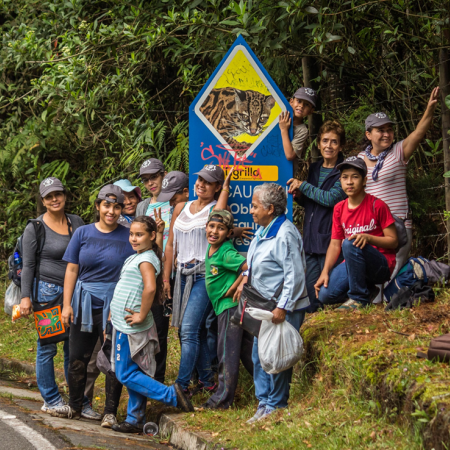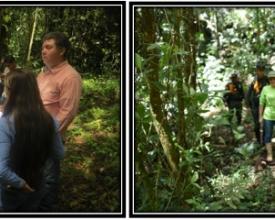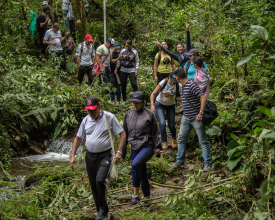SILAPE

40% of the territory of Envigado is protected area adopted by Agreement No. 009 of March 16, 2016 is approved for THE LOCAL SYSTEM OF PROTECTED AREAS OF THE MUNICIPALITY OF ENVIGADO (SILAPE), as one of the main strategies to ensure the conservation of strategic ecosystems, where forests, water resource, biodiversity, ecological confuncionalidad, including amnezanas species, vulnerable and others of the IUCM are included. In addition, there is a 7-year environmental management plan; this conservation strategy is also included in the Land Management Plan, decree 600 of 2019.
The Core Areas make up 3,299 ha of the urban and rural territory of the municipality. It defines 4 nuclei, guidelines, strategies and actions for the consolidation and sustainability of SILAPE over time:
Tigrillo Corridor Core Area, Perico and Pantanillo forests, Nare Forest Reserve, Eastern Escarpment, Trianon-Heliodora Wetland, Fragments Core Area.
Context
Challenges addressed
The following activities are critical steps necessary to formalize a local system of Local (Municipal) Protected Areas:
- Include in the Local Protected Areas System the most important natural systems of the territory.
- Identify the diversity of fauna and flora representative of the strategic ecosystems.
- Define the ecological structure as the basis for conservation and environmental management in the municipality of Envigado.
- Include the Local System of Protected Areas as protected soils in the Land Use Plan.
- Define Urban Protected Areas and formalize them as ecosystems that provide environmental goods and services for the urban population.
- Define corridors of species of importance for the connectivity and functionality of the ecosystems that make up the Regional System (felines).
Location
Process
Summary of the process
The 2011 Land Use Plan defined the need for management of Local Protected Areas with the objective of incorporating them into the land use plan in the medium term. From the identification of the species in the studies, the high importance of the local ecosystems became evident, especially the natural forest that still had connectivity and ecological functionality. With the participation of recognized institutions, the National University and the Von Humboldt Institute, the municipal ecological structure was defined with a high degree of certainty. This made it possible to close the land use planning cycle in 2019, including protected areas such as protected land and land of high importance.
All of the above processes emphasized important actions to bring knowledge of biodiversity to local stakeholders such as social leaders, educational institutions, and socio-environmental organizations.
Building Blocks
Agreement 009 whereby the Local System of Protected Areas is adopted and implemented.
The Municipal Council of Envigado adopted Agreement 009 which aims to contribute to the identification, conservation, management and proper management of strategic ecosystems and protected areas in the jurisdiction of the municipality, articulating these actions to departmental, regional and national management scales that strengthen human sustainability through the effective achievement of conservation objectives.
Enabling factors
Inclusion of the Local System of Protected Areas in the Land Management Plan in order to promote land uses that favor the protection and conservation of the associated fauna and flora.
Lesson learned
Importance of knowledge of the biodiversity of species to value local ecosystems and make it known by different means to promote the interest and ownership of institutions and the community in conservation.
Local conservation is successful when it is based on internal initiatives that integrate institutions and the community and is supported by knowledge, participation and norms that motivate or encourage the protection of ecosystems.
Land use planning and ecosystem conservation strategies should be closely related in order to define congruent conservation projects and decisions that are supported by national norms.
Resources
Management for the identification of biodiversity and participatory and motivational management for the restoration of Protected Areas.
In addition to the formality and territorial planning related to the Local System of Protected Areas, the municipality, based on environmental management, developed the following components as a highly important strategy:
- Promotion of incentives for community and landowner participation to restore natural protective vegetation that improves ecological connectivity and functionality.
- Awareness-raising and education actions to promote knowledge of the biodiversity of municipal ecosystems and the importance of SILAPE as a strategy to conserve this functionality and strategic ecosystems.
- Identifying the biodiversity of the different groups as fundamental knowledge to take actions for their conservation and encourage participation in conservation and conservation decisions in land use planning.
- Actions to protect endangered fauna in sites of connectivity disruption and vulnerability of highly important fauna species. Includes implementation of aerial wildlife crossings (61 installed).
Enabling factors
- The knowledge of local biodiversity based on technological tools that generated videos and clear images made it possible to see the important and abundant biodiversity of species, thus allowing unusual conservation decisions to be made in a territory that is part of a Metropolitan Area with high urban growth.
- The environmental management of the Secretariat of Environment in the different periods of governance has included the issue of Protected Areas as a component of high importance.
Lesson learned
- Ecosystem conservation depends on local enthusiasm and identification of the importance of biodiversity and strategic ecosystems.
- Management plans and conservation proposals must be included in land use plans.
- Protected area management should be approached from a regional perspective so that each municipality takes the model and implements it in its own municipality with a logic of connectivity and ecosystem globality.
- The participation of research institutions in the biodiversity identification process and in the formulation of protected area projects is of great importance; it avoids doubts about the importance and certainty of the proposals.
- Community participation motivated by the evidence of biodiversity and the functionality of ecosystems is of great importance to keep alive the enthusiasm for its dissemination and knowledge.
Impacts
During the process, 381 species of plants, 283 species of birds, 50 species of mammals, 17 species of amphibians, and 22 species of reptiles have been identified through monitoring stations. Among these are fauna species that are in some categories of threat, including endemic species, according to the IUCN Red List: Endangered: Gray marmoset(Saguinus leucopus).Vulnerable: Woolly tigrillo (Leopardus tigrinus), Cacique candela (Hypopyrrhus pyrohypogaster). Near Threatened: Cuniculus taczanowskii (Guagua de montaña), Cusumbo mocoso(Nasuella olivacea), Olinguito(Bassaricyon neblina), Perdiz colorada (Odontophorus hyperythrus) and some flora of conservation importance such as: Crested wax palm(Ceroxylon vogelianum), Monkey pot (Eschweilera antioquensis), Ivory(Licania cabrerae), Tartar fern(Cyathea sp.), Oak(Quercus humboldtii).
The community outreach program of forest rangers promotes environmental education, protection of water resources and reforestation in public and private properties. Including priority areas for the conservation of local and regional biodiversity, of importance for the urban-rural ecological structure.
Beneficiaries
- 240,000 inhabitants of the municipality of Envigado
- Biodiversity of species in the territory
Sustainable Development Goals
Story

The Protected Areas System involves the non-profit corporation Crear Unidos that works with young people with cognitive disabilities who have shown great interest and have participated in actions for the conservation and consolidation of the Local System of Protected Areas SILAPE.with cognitive disabilities who have shown great interest and have participated in actions for the conservation and consolidation of the Local System of Protected Areas SILAPE among which there are days called road operations in which the group of young people accompanied by the institutionality in which they educate and sensitize or motivate to conservation to drivers who travel on roads where they have identified fragmentation of ecosystems and that has run over wildlife species.


